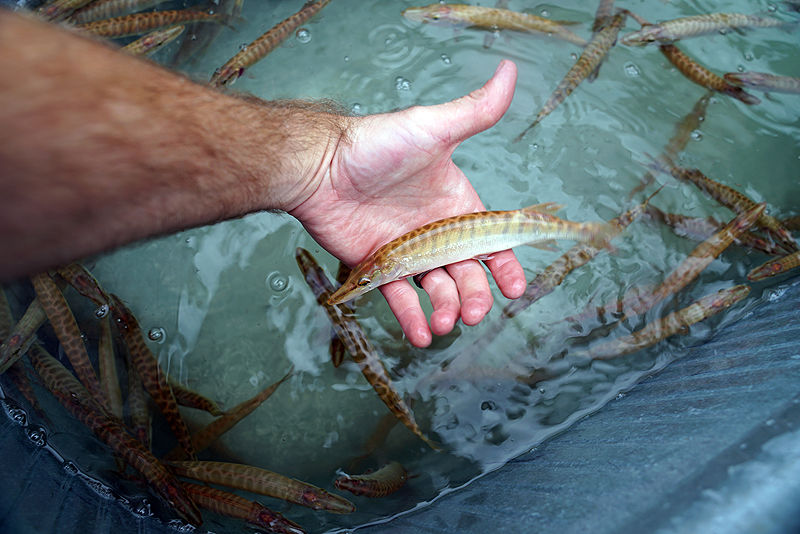DWR adopts new plan for Scofield
After an extensive public input process, the Division of Wildlife Resources has adopted a new management plan for the fishery at Scofield Reservoir.
The plan, which was presented to the central and southeastern regional advisory councils in July, includes introducing three new fish species to the reservoir—wiper, tiger muskie and sterile walleye.
Placing the three species in the reservoir will give anglers new fishing opportunities and hopefully help fishing remain good for years to come.
Scofield’s history
For decades, Scofield Reservoir was known as a great place to take your family fishing for rainbow trout. For a time, the reservoir was even listed among Utah’s Blue Ribbon fishing waters, some of the best fishing waters in the state. The presence of Utah chub has caused angler satisfaction to decline in recent years, though. Utah chub reproduce prolifically and outcompete rainbow trout for food and space. The chub were likely introduced to the reservoir illegally.
The chub problem is not a new problem at Scofield. For decades, aquatics managers have used rotenone, a chemical that kills fish, to remove Utah chub from the reservoir. The first rotenone treatment at Scofield happened in 1958. When the chub returned 20 years later, it was treated again, and 14 years after that, another treatment occurred.
Most recently, aquatic managers have used predatory species, such as cutthroat and tiger trout, to curb the chub population. Gill net surveys have shown that the cutthroat and tiger trout have effectively reduced the number of young chub in the reservoir. But chub can live up to 30 years, and the adults in the reservoir—which are too large for the trout to eat—haven’t died off yet. They’re still in Scofield and are still producing young chubs.
Public input
In fall 2016, the DWR conducted an online survey. The survey asked anglers what species they would like to pursue at Scofield and whether they would support another rotenone treatment. Responses from some 2,500 anglers across Utah revealed strong public support for introducing new species to the reservoir. Doing another rotenone treatment received mixed support.
Following the survey, aquatic managers organized a management committee. The committee included biologists, Scofield residents and volunteers who took the survey. Several sportsmen organizations were also represented, including the state’s Blue Ribbon Fisheries Council, Sportsmen for Fish and Wildlife, the DWR’s Southeastern Regional Advisory Council, and the Utah Wildlife Board. The purpose of the committee was to develop a sport fish management plan that would provide the DWR with recommendations and direction to create a sustainable, high-quality fishery at Scofield.
Six management priorities emerged from the group:
· Re-establish the family fishery, and make sure there are fish in the reservoir that people can catch and keep.
· Maintain and enhance trophy fishing opportunities.
· Enhance the diversity of fishing opportunities by adding new fish species.
· Reduce Utah chub numbers with a sustainable management model.
· Increase fishing and recreational use at the reservoir.
· Manage the reservoir in a way that’s compatible with the management of native fish species that live downstream.
A new approach
The new management plan addresses each of these goals, and the DWR has started implementing it. The goals in the plan include stocking Scofield Reservoir with three new species: wiper (a hybrid cross between a white bass and a striped bass), tiger muskie and triploid walleye.
Each of these species is sterile, which allows managers to control and adjust their numbers as needed. Adding the three species accomplishes several things: It enhances the diversity of fishing opportunities at Scofield, provides trophy fishing opportunities and introduces larger predators capable of controlling adult Utah chub.
“We need to reduce the chubs,” says Justin Hart, the DWR’s aquatics manager in southeastern Utah. “We don’t want to eliminate them completely, of course. We plan to use them to grow some big fish. But we do need to reduce their numbers.”
Hart says the new species will likely reach a catchable size by 2018, or sooner.
Rainbow trout still play an essential role in Scofield’s future. Next year, the DWR will stock rainbow trout that are several inches longer than those stocked in other waters. (Catchable rainbows stocked in other waters are usually 8 to 10 inches long.)
Stocking bigger rainbows will allow anglers to harvest and enjoy the rainbows immediately after they’re stocked. The agency will continue stocking cutthroat and tiger trout too.
Even though the wiper, tiger muskie and walleye that are being stocked can’t reproduce, managers are still taking precautions to prevent them from escaping from Scofield. A screen will be installed that will stop these species from moving downstream.
“That’s a big part of this plan too,” Hart says.
The rotenone option
While the plan to introduce new species to Scofield moves forward, a future rotenone treatment remains a possibility if the new species can’t adequately control the number of chubs. Aquatic managers have contracted with a private consulting firm to conduct a National Environmental Policy Act (NEPA) analysis of the reservoir, its tributaries and tail water should a rotenone treatment become necessary.
“We’re doing that right now,” Hart says. “We’ll have that analysis in our pocket, in case we need it.”.
The new management plan for Scofield Reservoir has a lifespan of five years. If the Utah chub population is not sufficiently reduced in that time, or if the new species fail to thrive, the reservoir will be treated with rotenone, Hart says.

